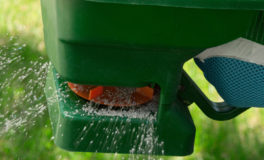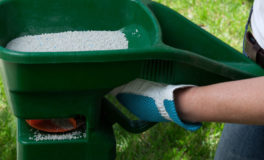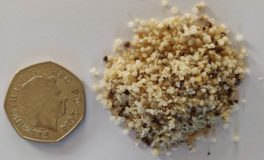Lawn feed tips for your new lawn – 08.09.22 – In the tricky task that is lawn care, feeding your new lawn is important, especially at this time of year. Knowing how to put fertiliser on grass is key information, as your new lawn is a sizeable investment in time and money . Feeding your lawn is not as cut-and-dry as it may first seem, and you may be asking yourself how do I fertiliser my grass? How often should I feed my lawn and how often to put weed and feed on the lawn?
Lawn fertiliser can make all the difference to a healthy new lawn. When it comes to how often your feed your lawn, there are a number of factors to consider. The time of year, weather conditions, soil type, grass species, aspect and wear and tear.
Additionally, weed and feed products can often be useful for getting rid of weeds as well as feeding the grass, all in one. If it’s a dry sunny day in the spring or autumn, spreading feed will help keep certain weeds at bay.
Why is lawn feed so important?
If your new lawn is not fed extra nutrients, the grass will use up the plant food reserve found within the soil, becoming pale and thin.
The average gardener trims their garden with the lawn mower twenty times a year. Since you mow the grass regularly, the grass needs some fibre in the soil to help it grow back stronger. Fertiliser is just that, and is needed to replenish the nutrients that have been extracted from the soil. If you have a busy garden with children and pets running around it, fertiliser will help keep the lawn looking green and thick even after a day’s use.
Lawn feed and fertiliser helps the grass develop thickness and side shoots. This helps to prevent moss and invasion from weeds that thrive in low-nutrient conditions.
Tips if your lawn was laid in spring
Spring is the season when the grass is at its most active. Not only is your newly laid turf busily putting its roots deep into your soil, but the leaves are growing back after a cold winter. So, it needs supplemental lawn feed to provide extra nutrients to the turf.
If you’ve used a pre-turfing fertiliser, your new turf will be taken care of for the first six weeks of feeding. If you have no preliminary turf fertiliser, wait four weeks and then follow the manufacturers’ instructions.
A granular lawn feed is by far the easiest to apply. Always use a properly-calibrated fertiliser spreader. That way you’ll get even coverage.
Always use a proprietary spring-summer lawn feed but not “weed and feed”. It is simply too harsh a treatment for young lawns at this early stage. Apply every 6 weeks until September and then change to autumn-winter lawn feed. On light, sandy soil you might want to feed every 4-5 weeks.
Tips if your lawn was laid in summer
If you laid turf between the months of July and September, your main focus is going to be making sure the plants have plenty of water. The sun is out and burning for long periods. In the UK that can be over 16 hours in high summer. So the plants drying up is a cause for concern.
When watering, irrigation tends to wash plant nutrients through the soil, so little and often is the key here. The time of day in which you water is important. Watering the turf during the middle of the day water will be evaporated immediately by the sun. Instead, water in the morning and night when it’s cooler and less bright, your lawn will retain more water.
You probably raked a pre-turf fertiliser into the soil before you laid turf, the plants are going to need it. If not, apply a spring-summer feed once the turf has had 3-4 cuts…..normally around 5 weeks after laying. The grass grows slower in summer than in spring but there’s still a lot of growing happening underground as the plants develop their root systems.
Products that can help…
 |
 |
Tips if your lawn was laid in autumn
During autumn, the soil is still warm. Hopefully, the weather is mild, so your turf will be working hard to put its roots down. It’s important at this time of year that the sward (leaves) doesn’t get too lush. New and soft growth is more susceptible to disease in autumn than at any other time, so be sure to watch out for that.
The pre-turfing fertiliser you worked into the soil before you laid your lawn should be enough to keep the plants going. If you didn’t get around to using it, apply an autumn-winter lawn feed 4-6 weeks after turfing. It is imperative that the lawn feed is low in nitrogen, like our Rejuvenator Autumn/Winter lawn feed, in order to prevent you from stimulating fast-growing but weak leaves. This feed is for the roots and nothing else.
 |
 |
Tips if your lawn was laid in winter
Contrary to what you may have heard, it is okay to lay turf in winter. Professional landscapers do it a lot and there are rarely any problems, however, the turf is not exactly the most vigorous at the time when it comes to establishing itself. The advantage of this is that there is little to no maintenance for you to do, as there is not likely to be anything more than minimal growth from the roots or the leaves at this time of year – unless of course, the weather is very mild.
In summary, there is no real need to feed winter-laid turf until the weather starts to warm up in March/April. Apply a spring/summer lawn feed, like our Vivid Green Spring/Summer lawn feed, to kick-start growth once the soil temperature reaches around 5 or 6 degrees Celsius, then continue to feed every 4-6 weeks depending on your soil type.
Tips if you are growing a lawn in the shade
Grass plants get some of their energy from the sun, so a lawn grown in the shade will need plenty of TLC. You may have used TurfOnline’s Shadesman+ turf, in which case you have the ideal lawn turf that will survive and grow. If light levels are low, it’s important that they’re not kept short of nutrients. Use lawn feed every 4 weeks in the spring and summer, and keep the mower blades as high as you dare.
Tips if you are growing a fine lawn or a bowling green
You have shallow-rooting grass species and you’re taking away their food factory (leaves) every other day. Feed little and often to help the grasses to cope with this unnatural maintenance regime. The first feed should be 4 weeks after laying using a seasonal lawn feed. Be vigilant. This type of grass needs intensive care!
Why is lawn feed so important?
If your new lawn is not fed extra nutrients, the grass will almost definitely use up the plant food reserve found within the soil, which will then turn your grass pale and thin.
Lawn feed helps develop the grass thickness and side shoots. This prevents the lawn seed from being exposed to invasion from moss and weed seeds, because they thrive in low-nutrient conditions.

 What is the best spring lawn feed?
What is the best spring lawn feed?  Spring lawncare jobs – feeding your lawn
Spring lawncare jobs – feeding your lawn  Lawn feed and the difference it makes to your lawn
Lawn feed and the difference it makes to your lawn 

